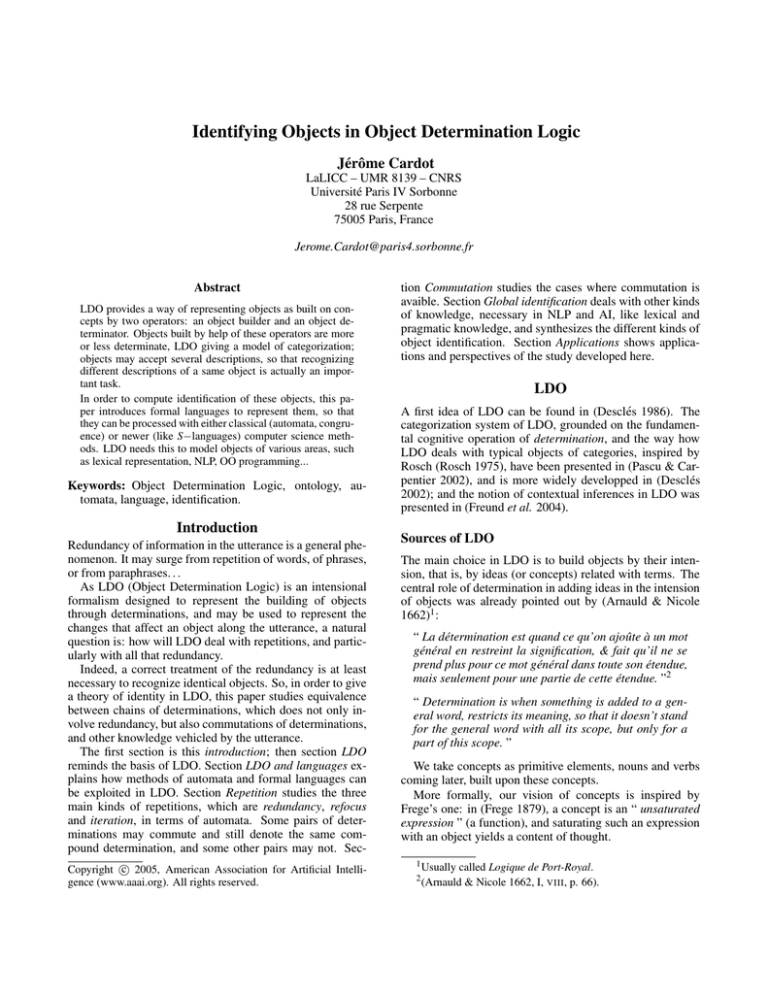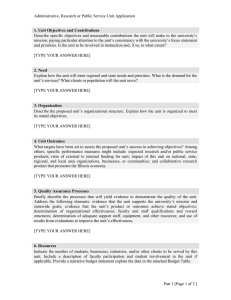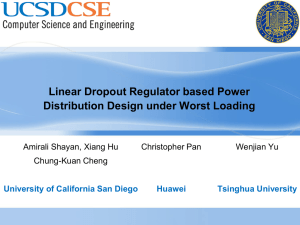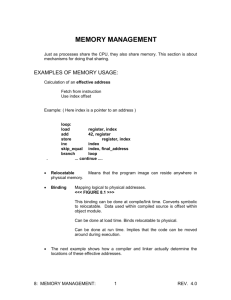
Identifying Objects in Object Determination Logic
Jérôme Cardot
LaLICC – UMR 8139 – CNRS
Université Paris IV Sorbonne
28 rue Serpente
75005 Paris, France
Jerome.Cardot@paris4.sorbonne.fr
Abstract
LDO provides a way of representing objects as built on concepts by two operators: an object builder and an object determinator. Objects built by help of these operators are more
or less determinate, LDO giving a model of categorization;
objects may accept several descriptions, so that recognizing
different descriptions of a same object is actually an important task.
In order to compute identification of these objects, this paper introduces formal languages to represent them, so that
they can be processed with either classical (automata, congruence) or newer (like S−languages) computer science methods. LDO needs this to model objects of various areas, such
as lexical representation, NLP, OO programming...
Keywords: Object Determination Logic, ontology, automata, language, identification.
Introduction
Redundancy of information in the utterance is a general phenomenon. It may surge from repetition of words, of phrases,
or from paraphrases. . .
As LDO (Object Determination Logic) is an intensional
formalism designed to represent the building of objects
through determinations, and may be used to represent the
changes that affect an object along the utterance, a natural
question is: how will LDO deal with repetitions, and particularly with all that redundancy.
Indeed, a correct treatment of the redundancy is at least
necessary to recognize identical objects. So, in order to give
a theory of identity in LDO, this paper studies equivalence
between chains of determinations, which does not only involve redundancy, but also commutations of determinations,
and other knowledge vehicled by the utterance.
The first section is this introduction; then section LDO
reminds the basis of LDO. Section LDO and languages explains how methods of automata and formal languages can
be exploited in LDO. Section Repetition studies the three
main kinds of repetitions, which are redundancy, refocus
and iteration, in terms of automata. Some pairs of determinations may commute and still denote the same compound determination, and some other pairs may not. Secc 2005, American Association for Artificial IntelliCopyright gence (www.aaai.org). All rights reserved.
tion Commutation studies the cases where commutation is
avaible. Section Global identification deals with other kinds
of knowledge, necessary in NLP and AI, like lexical and
pragmatic knowledge, and synthesizes the different kinds of
object identification. Section Applications shows applications and perspectives of the study developed here.
LDO
A first idea of LDO can be found in (Desclés 1986). The
categorization system of LDO, grounded on the fundamental cognitive operation of determination, and the way how
LDO deals with typical objects of categories, inspired by
Rosch (Rosch 1975), have been presented in (Pascu & Carpentier 2002), and is more widely developped in (Desclés
2002); and the notion of contextual inferences in LDO was
presented in (Freund et al. 2004).
Sources of LDO
The main choice in LDO is to build objects by their intension, that is, by ideas (or concepts) related with terms. The
central role of determination in adding ideas in the intension
of objects was already pointed out by (Arnauld & Nicole
1662)1 :
“ La détermination est quand ce qu’on ajoûte à un mot
général en restreint la signification, & fait qu’il ne se
prend plus pour ce mot général dans toute son étendue,
mais seulement pour une partie de cette étendue. ”2
“ Determination is when something is added to a general word, restricts its meaning, so that it doesn’t stand
for the general word with all its scope, but only for a
part of this scope. ”
We take concepts as primitive elements, nouns and verbs
coming later, built upon these concepts.
More formally, our vision of concepts is inspired by
Frege’s one: in (Frege 1879), a concept is an “ unsaturated
expression ” (a function), and saturating such an expression
with an object yields a content of thought.
1
2
Usually called Logique de Port-Royal.
(Arnauld & Nicole 1662, I, VIII, p. 66).
Objects and determination in LDO
In LDO objects are built, and may be more or less determinate, by use of operators τ and δ acting upon concepts:
τ : builds, upon a notion f , τ f , typical object f , the typical
indeterminate object associated to notion f .
δ: builds, upon a notion f , δf , a determination, that is, an operator acting upon an object x and building a more determinate object (δf )x. So an object may be built by several
determinations acting one after the other, and we’ll write
∆ for a determination chain.
τf
τ /BE - WOMAN/ = a woman
δg1
δg1 (τ f )
δg2
δg2 (δg1 (τ f ))
δg3
δ /BE - BROWN - HAIRED/
a brown-haired woman
δ /BE - YOUNG/
a young brown-haired woman
δ /BE - ELEGANT/
δg3 (δg2 (δg1 (τ f ))) an elegant young brown-haired woman
Figure 1: Determinations of objects.
The class of concepts is denoted by F, the class of objects
by O.
LDO as a Leśniewskian ontology
The sole axiom of Leśniewskian system of ontology is the
following (we give here the 1920 version of the axiom, longer but easier to read than the 1929 version). Our transcription follows Leśniewski’s choice of writing single objects in
capitals, and what may be several objects in lower case:
Axiom 1 (AO - 1920)
The object A is a if and only if:
i. there is an object B such that B is A;
ii. if the object B is A and the object C is A, then the
object B is C;
iii. if an object B is A, then B is a.
(∀Aa)(ε{Aa} ≡(∼ ((∀B)(∼ (ε{BA})))
∧ (∀BC)((ε{BA} ∧ ε{CA}) ⇒ ε{BC})
∧ (∀B)(ε{BA} ⇒ ε{Ba})))
Leśniewskian ontology involves ε as a prefixed primitive
symbol, representing the copula (to be). In LDO we will
introduce an analogue to ε, denoted by ε (infixed), in the
following definition:
Definition 2 (Specification of an object)
xεy if, and only if, there is a chain of determinations ∆,
possibly empty – that is, ∆ would be reduced to identity –
such that x = ∆y.
We read xεy “ x is a specification of y ”, or “ x is a y ”.
With the specification relation we can characterize completely determinate objects:
Definition 3 (Completely determinate objects)
We say that an object x is completely determinate if, and
only if, one of the two equivalent following properties is verified:
i. x is a fixed point of any applicable determination;
ii. from any two specifications of x, each one is a specification of the other one.
Denoting the class of completely determinate objects by
Odet , we have:
∀A, A ∈ Odet ≡ ∀BC((BεA ∧ CεA) ⇒ BεC)
We also denote by Oind the class of objects which are not
in Odet , that is the class of not completely determinate objects, so we have O = Oind ∪ Odet .
Interpreting here ε{Ab} as “ A is a specification of b ”, we
get the theorem:
Theorem 4 Objects of LDO build a Leśniewskian system of
ontology.
Proof : Property ii) of definition 3 leads to the second of the
three requisites in axiom 1:
(∀BC)((ε{BA} ∧ ε{CA}) ⇒ ε{BC}).
The two other requisites are straightforward.
The class of all specifications of τ f (the scope of f ) is
denoted by Étendue f . Among these specifications, some
objects are completely determinate: they constitute the extension of f , denoted by Extension f .
So we have Extension f = Étendue f ∩ Odet .
LDO and languages
Further in this article, our aim will be to recognize when the
objects δgk · · · δg1 τ f and δg0` · · · δg01 τ f 0 may be identified,
in other words when δgk · · · δg1 τ f = δg0` · · · δg01 τ f 0 . Indeed,
we shall only examine the case f = f 0 , that is, we restrict the
problem to identification of objects within Étendue f .
Intuitively, this is not really a restriction, because if the
two objects a = δgk · · · δg1 τ f and a0 = δg0` · · · δg01 τ f 0 may
be identified, there must be a common ancestor to τ f and
τ f 0 , otherwise a and a0 would simply be far too different
from each other for the question of identifying them to be
askable.
There is a simple order morphism between words of F ∗
(the free monoid language built on the alphabet F), ordered
by the prefix order, and objects of Étendue f , ordered by the
converse of ε:
ϕ : F ∗ −→ O
g1 g2 · · · gn 7−→ δgn ◦ · · · δg2 ◦ δg1 ◦ τ f
Recalling the example of figure 1, an elegant young
brown-haired woman, described in Étendue /BE - WOMAN/,
is:
δ/BE - ELEGANT/ ◦ δ/BE - YOUNG/◦
δ/BE - BROWN - HAIRED/ ◦ τ /BE - WOMAN/
This object of Étendue /BE - WOMAN/ will be represented
by the word of F ∗ :
/BE - BROWN - HAIRED/ /BE - YOUNG/ /BE - ELEGANT/.
So ϕ maps words of F ∗ to objects of Étendue f . We will
say that a word g1 · · · gk refers in Étendue f to the object
δgk · · · δg1 τ f .
Now, if every repetition is allowed, we transform the automata by adding a return 1−arc for each arc of the initial
automata. This leads to automata drawn figure 4.
Definition 5 Let x be an object of Étendue f . The set of all
words of F ∗ referring to x in Étendue f is called the language referring to x, and denoted by Lx .
Figure 4: Automata recognizing all repetitions on the pattern
abc
Lx = ϕ
−1
∗
{x} = {m ∈ F ; ϕ(m) = x}
Repetition
In this section we examine the link between repetition of
determinations and the language referring to an object. We
have to distinguish between three kinds of repetitions:
a
c
b
1−arcs are easily removed: each path tagged by 1 n α is to
be replaced by an arc tagged by α, with the same extremities
than the initial path. Applied to the automata of figure 4, this
leads to the one of figure 5.
a
a
• pure redundancy: the repetition doesn’t give any new information;
b
a
b
c
c
b
a
• refocus: the repetition focuses on the center of an idea;
Figure 5: Automata without 1−arc, recognizing all repetitions on the pattern abc
Indeed, determination is a constructive operation on objects. Pure redundancy corresponds to an idempotent determination, refocus realizes idempotency after the second
step, and with iteration the building goes on.
This process builds, on a word, the language of all words
obtained by repetitions of parts of the primer word. Although rational expressions are perfectly suitable to represent the modified language, the easier representation, even
for studying properties of such languages, is that of automata
with 1−arc.
A converse part of the problem is, from a given word, to
eliminate all repetitions. We can try to do this with a rewriting rule like the following one: uv2 w −→ uvw.
Each application of this rule reduces the length of the
word. So the relation associated to this rule is clearly nœtherian, that is, from a given word the graph of the relation does
not show infinite path – in other words the rule can not be
iterated infinitely.
Unfortunately this relation does not have the ChurchRosser property of convergence. To win the convergence,
we have to use the following rule: uvwvuvw −→ uvw.
Hence we get:
• iteration: repetition makes one determination more, after
the first determination (and changes the changed object).
Repetition as redundancy
Let us examine the possibility of repeating one or all determinations, and still referring to the same object. We can
transform the automata of figure 2, which recognizes only
the word abc, to express for example that if b is repeated,
the new word still refers to the same object as abc does. This
transformation simply consists in adding a new arc, tagged
with the empty word3 . Such an arc will be written a 1−arc.
a
b
c
Figure 2: Automata recognizing the word abc
Figure 3 shows the transformed automata. Allowing repetitions of b is translated in terms of regular expression: the
b of the initial form abc is replaced by bb∗ , or by bn in terms
of formal languages.
a
b
c
Figure 3: Automata recognizing the language ab n c
3
We make here the choice of denoting the empty word by 1, as
does J.-M. Autebert in (Autebert 1994), to avoid another use of ε
in this article. Arcs tagged by 1 will be dotted.
Proposition 6 The reduced word by the relation associated
with the former rewriting rule is the shortest word of a language allowing all repetitions.
Proof : The relation is nœtherian, convergent and length
decreasing.
Repetition as refocus
In natural language not all repetitions are redundant. For
example, speaking of a black, black dog, we don’t only refer
to a black dog, but to a a really black dog, a dog that doesn’t
have even a white tuft at the end of its tail.
That is what we call refocus, and we will express it in
terms of words of F ∗ by a rewriting rule: aa −→ Ta where
Ta denotes “ be a typical a ”.
Of course we require a dictionary to express which concepts obey this rule, and more important, this rule must
be applied before the reduction of repetitions presented
above (see Redundancy), otherwise there wouldn’t be any
sequence aa left in the word to be transformed into Ta. And
the rule has to be applied only once: once the object has
been recognized as a typical f , it is not relevant to check
again whether it is typical.
Let us recall that, given V = {a1 , a2 , · · · , ak } a set of letters, or alphabet (written here in an alphabetic order), and
w ∈ V ∗ a word on that alphabet, the Parikh vector of w is
the list (|w|a1 , · · · , |w|ak ) where |w|ai is the number of occurrences of ai in w.
Then a more efficient way to recognize refocus is to compute the Parikh vector of the analyzed word: we just have
to find letters appearing more than once in the word, and
search them in the dictionary of refocusing. Once possible
typicality has been recognized, remaining repetitions may
be reduced, expressing redundancy.
Repetition as iteration
Some determinations may be applied and still change the
object, even after several steps. Let us recall a stupid high
school joke:
Example 7 A scientist studies how fleas jump. He tells a
flea to jump, and the flea jumps. He cuts one leg of the flea,
and tells it to jump, and the flea jumps. He cuts one leg of the
flea, tells it to jump, and the flea hardly jumps. He cuts one
leg of the flea, tells it to jump, and the flea does not move.
He concludes: when we cut legs of a flea, the flea goes deaf.
As for Refocus, the right tool to treat that kind of repetition is to compute the Parikh vector of the analyzed word,
storing the occurrence number of each letter.
Commutation
This section deals with the order of determinations applied
to build an object. Clearly, if determinations were commutative (as we’ll see later, some application domains of LDO
may accept that), letters of a word referring to an object
could be written in an arbitrary order, say for example an
alphabetical order chosen on F. In that case the set of letters of the word, possibly associated with the Parikh vector,
would be enough to refer to the object.
This is not the general case: determinations do not commute in general, but some pairs of determinations may commute. Intuitively, if concepts are independent, then the associated determinations commute. For example, when speaking of a big black dog or of a black big dog we refer to the
same object.
So we have to identify the objects that are identical because of some determination commutation.
Commutative and non-commutative
determinations
The problem here is, knowing that δb and δc commute, to
recognize that abcd and acbd refer to the same object. And
still we may want to choose one of the two words to represent canonically the object.
This can be done, provided we define an alphabetic order
on F, by giving the following rule:
cb −→ bc (where b < c in that F alphabetic order).
Let us gather such commutative rewriting rules together
in a set, a Thue system (Autebert 1994) that will be written
κ (for commutation). Application of κ−rules is a nœtherian
relation, decreasing the alphabetic order of the word without changing its length. The associated congruence identifies objects differing only by order of commuting determinations, and κ−rules lead to the canonic word representing
the object.
S−languages
S. R. Schwer (Schwer 2001) presented the formalism of
S−languages based on an alphabet X: the letters of the
S−alphabet associated with X are the non-empty subsets of
b and an S−language is a
X. That S−alphabet is denoted by X,
language on the S−alphabet. She introduced that formalism
in order to abstract unknown temporal information, that is to
abstract possibilities in an order.
S−languages proved to be an efficient way of representing
commuting determinations: in Étendue f , identifying objects that are identical because of some determination commutation is precisely abstracting an information in the order
induced by determination.
Thus, if δb and δc commute, both wordsabcd
and acbd
b
may be abstracted into the same S−word a
d.
c
This S−word gives an easy access to the class of words
it abstracts, and to the canonic word representing the object,
whereas mapping the class from the canonic word, although
computable, is less intuitive.
Global identification
We still have to deal with other reasons of identification, but
this will not require new kinds of tools. Then we have to
mix all these methods.
Other knowledge
Concerning other kinds of knowledge leading to different
ways of identifying objects, we shall treat them as we did
for commutation: we build a different Thue system for each
kind of knowledge (of course they could be merged together,
but keeping them apart increases readability and maintenability).
These systems are:
λ for lexicon. Rules of this system are like:
/BE - RECTANGLE//BE - RHOMBUS/ −→ /BE - SQUARE/
U for incompatibility. Up to this point, when writing a
word of F ∗ , we did not care whether the referred object
in Étendue f exists or not. Incompatibility rules allow to
treat impossible objects. We just have to add a symbol for
non-existing objects, for example Λ, and an incompatibility rule will look like:
/BE - RAINY//BE - DOG/ −→ Λ.
π for pragmatics. Pragmatic rules allow to introduce knowledge about the real world (or about a fictive world we
would want to represent).
Synthesis
Figure 6 shows how the different ways of identifying objects
of Étendue f are chained: ψ for repetitions, κ for commutations, λ for lexicon, U for incompatibility and π for pragmatics.
λ
∗
∗
F ∗ / ←→
F ∗ / ←→
ψ,κ
ψ,κ,λ
U
κ
∗
∗
F ∗ / ←→
F ∗ / ←→
ψ
ψ,κ,λ,U
ψ
F∗
π
ϕ
O
Figure 6: Diagram of objects as classes of F ∗
Applications
We present here two domains of possible applications of
identity in LDO: applications to Computer Science, and applications to Natural Language Processing.
Model of OO-computation
In an OO-language where every class and every object is
specified from a general class, the requisite we accepted in
section LDO and languages, that is identifying objects, provided they have a common ancestor, is clearly fulfilled.
Then we can interpret OO-operations that build entities
(classes or objects) of an OO-program as follows:
class specification is a determination, where the specification consists in defining a new method, a new attribute or
in setting a class attribute;
class specification with overriding makes the more determinate class behave differently than the general class; it
does not have the default behaviour, and may be considered as an atypical class;
multiple inheritance corresponds to the use of two different chains of determinations; if no conflict occurs, the two
chains are independent and commute; if there is a conflict,
one order between the two determinations may be more
suitable than the other possible one;
instanciation of an object of a class is a determination; we
even can consider that this determination gives to the object its memory address as an identificator, so that another
instance of the same class cannot be identified with it;
setting an attribute is also a determination.
An object can not be atypical of the class it is an instance
of, but through this class it may be atypical of an ancestor
class.
So, the main structural operations on OO-entities have
been modeled in terms of LDO. It is now possible to check
the hierarchy of classes, trying to identify some abstract
classes, in order to factorize some determinations (i.e. some
specification of methods) and to optimize the hierarchy.
Determination and the lexicon
As we have shown in (Cardot 2003), LDO may be used to
represent a structured lexicon. Indeed, as we showed with
theorem 4, LDO follows the structure of Leśniewski’s system of ontology (Leśniewski 1929), also called by Twardowski the proper calculus of names.
So the names are directly represented by LDO (see above
Other knowledge), whereas the semantic of verbs may be
represented by a scheme of their action on the terms they
receive as arguments. This action is given in terms of determination, for example die transforms a subject with a determination (which can be implicit) δ/BE - ALIVE/ into a subject
with the determination δ/NOT BE - ALIVE/.
Determination and text analysis
When objects are introduced in a text, they are not determinate; then the text brings more and more determinations.
Determiners follow the same scheme, so when we speak of
a new character we can say a man, and when we later refer
to the same one, we have to use the definite form the man,
otherwise a man would be understood as another man. Using an indeterminate noun phrase introduces a new object in
the text.
So the different determiners – or quantifiers – in natural
language act to restrict the scope of the noun, precisely as
determinations act in LDO.
LDO, with a method of identifying objects along the text,
allows to model how new informations build the object further. Thus the text may be seen as a list of constructive instructions about the objects it deals about.
Note that the information given along the text may be nonmonotonic, and may therefore need some revision if a new
determination conflicts with older ones.
Conclusion
We have developed in this article methods for computing a
formal identity of objects in LDO. This step was necessary
to get the benefit of the intensional constructive way objects
are built in that system.
Hence LDO promises wide domains of application. The
determination of objects is involved in structuring a lexicon,
in understanding a text. . . We have shown a model of class
hierarchies of OO programming languages, and this model
may be adapted to any knowledge representation system allowing inheritance, or be used to check and improve class
hierarchies.
We still have to emphasize that the way we compute
identity between objects does not require that these objects
are completely determinate: the system deals with general
classes the same way than with determinate objects, so that
general or abstract classes can be identified too.
Acknowledgements
Thanks are due to the referees whose suggestions helped
in improving a former version of this article. As one of
them suggested, I give more detailed information on the subject online, available at http://www.lalic.paris4.
sorbonne.fr/cardot/research/LDO/
And I am particularly grateful to S. R. Schwer and J.P. Desclés for numerous discussions about LDO and languages.
References
Arnauld, A., and Nicole, P. 1662. La logique ou l’art de
penser. Paris: Vrin, 1993 edition.
Autebert, J.-M. 1994. Théorie des langages et des automates. Paris: Masson.
Cardot, J. 2003. Logique de la détermination d’objets:
un formalisme pour la représentation des objets du discours. In Actas del VIIIvo symposio internacional de comunicación social, 115–120.
Desclés, J.-P. 1986. Implication entre concepts: la notion de typicalité. Travaux de linguistique et de littérature
(XXIV).
Desclés, J.-P. 2002. Categorisation: a logical approach to a
cognitive problem. Journal of Cognitive Science 3(2):85–
137.
Frege, G. 1879. Begriffsschrift, eine der arithmetischen
nachgebildete Formelsprache des reinen Denkens. Halle.
Freund, M.; Desclés, J.-P.; Pascu, A.; and Cardot, J. 2004.
Typicality, contextual inferences and object determination
logic. In Proceedings of FLAIRS 2004, 491–495.
Leśniewski, S. 1929. Grundzüge eines neuen Systems der
Grundlagen der Mathematik. Fundamenta Mathematicae
14.
Pascu, A., and Carpentier, F.-G. 2002. LDO, a categorization system. In Proceedings of FLAIRS 2002, 178–180.
Rosch, E. 1975. Cognitive representations of semantic categories. Journal of Experimental Psychology (104):192–
233.
Schwer, S. R. 2001. S−arrangements avec répétitions.
Comptes rendus de l’Académie des Sciences de Paris
(334):261–266.






